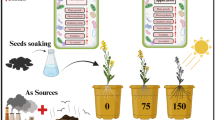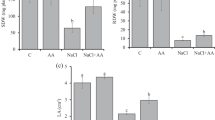Abstract
Feeling prone to stress differs with plant production stage, water scarcity near commencement of grain filling phase has a significant reduced grain yield through fewer endosperm and sink cells capacity that minimize the accumulation of dry matter and assimilates supplies. In greenhouse research was conducted to investigate the part of silicon (Si) in regulating the production, yield and physico-chemical traits of wheat (Triticum aestivum L.) under drought situation. Two commercial good varieties of wheat (Chakwal-50 and Sehar-06) were planted under well water (100% FC) and water stress conditions (60% FC) pooled with Si 3 mM (seed priming), 1 mM (fertilization) and 4 mM (foliar application). In tillering and anthesis stage, yield and yield elements, leaf pigments, gaseous exchange parameters, biochemical and nutrients were analyzed from the wheat plants. The stress of water deficit prompted a marked reduction in agronomic parameters while biochemical attributes were increased under conditions of water stress except for total soluble proteins. The effect of Si was found to be positive at both the stages under well-watered and drought affected wheat plants. At anthesis stage, foliarly applied Si enhanced biochemical attributes and accumulation of nutrients under the stress of water deficit and normal water plants, respectively. Under normal conditions, the most successful method was the taking of leaf Ca by Si foliar spray at anthesis level. Applied with no Si the water stressed plants retained the optimum concentration of Fe. Here as well, Si fertigation under well water condition was found to be better for studied agronomic parameters at the tillering stage. It may be included that Si application improves plant biochemical attributes, absorbs nutrients and shows higher growth rate which ultimately helps the plant mitigate the drought-stressing effects. At the anthesis stage, foliar spray was stronger while at the tillering stage, fertigation produced good results.
Similar content being viewed by others
References
Ahmad Z, Waraich EA, Barutçular C, et al (2020) Enhancing drought tolerance in wheat through improving morpho- physiological and antioxidants activities of plants by the supplementation of foliar silicon. https://doi.org/10.32604/phyton.2020.09143
Waraich EA, Rashid F, Ahmad Z, Ahmad R, Ahmad M (2020) Foliar applied potassium stimulate drought tolerance in canola under water deficit conditions. J Plant Nutr 0:1–12. https://doi.org/10.1080/01904167.2020.1758132, 43
Ahmad Z, Anjum S, Iqbal MA, Saeed-ur-Rehman H (2018) Foliar applied potassium enhances fibre quality, water foliar applied potassium enhances fibre quality, water relations and yield of cotton. J Agric Res 56:17–25
Gao L, Caldwell CD, Jiang Y (2018) Photosynthesis and growth of camelina and canola in response to water deficit and applied nitrogen. Crop Sci 58:393–401. https://doi.org/10.2135/cropsci2017.07.0406
Ahmad Waraich E, Ahmed Z, Ahmad Z et al (2020) Alterations in growth and yield of Camelina induced by different planting densities under water deficit stress. Phyton (B Aires) 89:587–597. https://doi.org/10.32604/phyton.2020.08734
Seyahjani EA, Yarnia M, Farahvash F et al (2020) Influence of rhizobium, pseudomonas and mycorrhiza on some physiological traits of red beans (Phaseolus vulgaris l.) under different irrigation conditions. Legum Res. https://doi.org/10.18805/LR-454
Mohtashami R, Movahhedi Dehnavi M, Balouchi H, Faraji H (2020) Improving yield, oil content and water productivity of dryland canola by supplementary irrigation and selenium spraying. Agric Water Manag 232:106046. https://doi.org/10.1016/j.agwat.2020.106046
Ahmad Z, Anjum S, Waraich EA, Ayub MA, Ahmad T, Tariq RMS, Ahmad R, Iqbal MA (2018) Growth, physiology, and biochemical activities of plant responses with foliar potassium application under drought stress–a review. J Plant Nutr 41:1734–1743
Mahmood A, Kanwal H, Kausar A et al (2019) Seed priming with zinc modulate growth, pigments and yield of chickpea (Cicer arietinum l.) under water deficit conditions. Appl Ecol Environ Res. https://doi.org/10.15666/aeer/1701_147160
Shahsavari N (2019) Effects of zeolite and zinc on quality of canola (Brassica napus L.) under late season drought stress. Commun Soil Sci Plant Anal. https://doi.org/10.1080/00103624.2019.1604729
Sharma M, Gupta SK, Majumder B, Maurya VK, Deeba F, Alam A, Pandey V (2017) Salicylic acid mediated growth, physiological and proteomic responses in two wheat varieties under drought stress. J Proteome 163:28–51. https://doi.org/10.1016/j.jprot.2017.05.011
El Sabagh A, Hossain A, Barutçular C et al (2019) Effects of drought stress on the quality of major oilseed crops: implications and possible mitigation strategies - a review. Appl Ecol Environ Res 17:4019–4043. https://doi.org/10.15666/aeer/1702_40194043
Zhang W, Yu X, Li M, Lang D, Zhang X, Xie Z (2018) Silicon promotes growth and root yield of Glycyrrhiza uralensis under salt and drought stresses through enhancing osmotic adjustment and regulating antioxidant metabolism. Crop Prot 107:1–11. https://doi.org/10.1016/j.cropro.2018.01.005
Sallam A, Alqudah AM, Dawood MFA, Baenziger PS, Börner A (2019) Drought stress tolerance in wheat and barley: advances in physiology, breeding and genetics research. Int J Mol Sci 20
Guo R, Shi L, Jiao Y, Li MX, Zhong XL, Gu FX, Liu Q, Xia X, Li HR (2018) Metabolic responses to drought stress in the tissues of drought-tolerant and drought-sensitive wheat genotype seedlings. AoB Plants 10. https://doi.org/10.1093/aobpla/ply016
Barnawal D, Bharti N, Pandey SS, Pandey A, Chanotiya CS, Kalra A (2017) Plant growth-promoting rhizobacteria enhance wheat salt and drought stress tolerance by altering endogenous phytohormone levels and TaCTR1/TaDREB2 expression. Physiol Plant 161:502–514. https://doi.org/10.1111/ppl.12614
Ma J, Li R, Wang H, Li D, Wang X, Zhang Y, Zhen W, Duan H, Yan G, Li Y (2017) Transcriptomics analyses reveal wheat responses to drought stress during reproductive stages under field conditions. Front Plant Sci 8. https://doi.org/10.3389/fpls.2017.00592
Fani E, Hassibi P, Meskarbashee M et al (2019) Effect of drought stress and silica spraying on some physiological and functional traits of canola cultivars. Bulg J Agric Sci 25:62–66
Souri Z, Khanna K, Karimi N, Ahmad P (2020) Silicon and plants: current knowledge and future prospects. J Plant Growth Regul. https://doi.org/10.1007/s00344-020-10172-7
Cao B-L, Wang L, Gao S et al (2017) Silicon-mediated changes in radial hydraulic conductivity and cell wall stability are involved in silicon-induced drought resistance in tomato. Protoplasma 254:2295–2304. https://doi.org/10.1007/s00709-017-1115-y
Chen D, Wang S, Yin L, Deng X (2018) How does silicon mediate plant water uptake and loss under water deficiency? Front Plant Sci 9. https://doi.org/10.3389/fpls.2018.00281
Laane HM (2017) The effects of the application of foliar sprays with stabilized silicic acid: an overview of the results from 2003-2014. Silicon. 9:803–807. https://doi.org/10.1007/s12633-016-9466-0
Laane HM (2018) The effects of foliar sprays with different silicon compounds. Plants 7(2):45
Agostinho FB, Tubana BS, Martins MS, Datnoff LE (2017) Effect of different silicon sources on yield and silicon uptake of rice grown under varying phosphorus rates. Plants. 6. https://doi.org/10.3390/plants6030035
Artyszak A (2018) Effect of silicon fertilization on crop yield quantity and quality—A literature review in Europe. Plants 7(3):54
Schaller J, Turner BL, Weissflog A, Pino D, Bielnicka AW, Engelbrecht BMJ (2018) Silicon in tropical forests: large variation across soils and leaves suggests ecological significance. Biogeochemistry. 140:161–174. https://doi.org/10.1007/s10533-018-0483-5
Gou T, Yang L, Hu W, Chen X, Zhu Y, Guo J, Gong H (2020) Silicon improves the growth of cucumber under excess nitrate stress by enhancing nitrogen assimilation and chlorophyll synthesis. Plant Physiol Biochem 152:53–61. https://doi.org/10.1016/j.plaphy.2020.04.031
Gao M, Zhou J, Liu H, Zhang W, Hu Y, Liang J, Zhou J (2018) Foliar spraying with silicon and selenium reduces cadmium uptake and mitigates cadmium toxicity in rice. Sci Total Environ 631-632:1100–1108. https://doi.org/10.1016/j.scitotenv.2018.03.047
Khan W-D, Aziz T, Iqbal M, Ramzani PMA, Rasool K, Rahman SU, Anwar MN (2017) WITHDRAWN: soil and foliar silicon application enhances maize grain yield, its proximate composition, and antioxidant mechanisms under saline field conditions. Plant Physiol Biochem. https://doi.org/10.1016/j.plaphy.2017.08.023
Deus ACF, de Mello PR, de Cássia Félix Alvarez R et al (2020) Role of silicon and salicylic acid in the mitigation of nitrogen deficiency stress in Rice plants. Silicon. 12:997–1005. https://doi.org/10.1007/s12633-019-00195-5
Ali S, Rizwan M, Hussain A et al (2019) Silicon nanoparticles enhanced the growth and reduced the cadmium accumulation in grains of wheat (Triticum aestivum L.). Plant Physiol Biochem. https://doi.org/10.1016/j.plaphy.2019.04.041
Merwad ARMA, Desoky ESM, Rady MM (2018) Response of water deficit-stressed Vigna unguiculata performances to silicon, proline or methionine foliar application. Sci Hortic (Amsterdam) 228:132–144. https://doi.org/10.1016/j.scienta.2017.10.008
Ahmad Z, Waraich EA, Ahmad R, Shahbaz M (2017) Modulation in water relations, chlorophyll contents and antioxidants activity of maize by foliar phosphorus application under drought stress. Pak J Bot 49:11–19
Waraich EA, Ahmad Z, Ahmad R, Saifullah, Ashraf MY (2015) Foliar applied phosphorous enhanced growth, chlorophyll contents, gas exchange attributes and PUE in wheat (Triticum aestivum L.). J Plant Nutr 38:1929–1943. https://doi.org/10.1080/01904167.2015.1043377
Waraich EA, Ahmed Z, Ahmad Z, et al (2020) Alterations in growth and yield of Camelina induced by different planting densities under water De fi cit stress. 1–11. https://doi.org/10.32604/phyton.2020.08734
Nawaz F, Ahmad R, Ashraf MY, Waraich EA, Khan SZ (2015) Effect of selenium foliar spray on physiological and biochemical processes and chemical constituents of wheat under drought stress. Ecotoxicol Environ Saf 113:191–200. https://doi.org/10.1016/j.ecoenv.2014.12.003
Nawaz F, Ashraf MY, Ahmad R, Waraich EA, Shabbir RN, Bukhari MA (2015) Supplemental selenium improves wheat grain yield and quality through alterations in biochemical processes under normal and water deficit conditions. Food Chem 175:350–357. https://doi.org/10.1016/j.foodchem.2014.11.147
Coskun D, Britto DT, Huynh WQ, Kronzucker HJ (2016) The role of silicon in higher plants under salinity and drought stress. Front Plant Sci 7. https://doi.org/10.3389/fpls.2016.01072
Akinwale RO, Awosanmi FE, Ogunniyi OO, Fadoju AO (2017) Determinants of drought tolerance at seedling stage in early and extra-early maize hybrids. Maydica 12;62(1):9
Ahmad R, Waraich EA, Nawaz F, Ashraf MY, Khalid M (2016) Selenium (se) improves drought tolerance in crop plants - a myth or fact? J Sci Food Agric 96:372–380
Laxa M, Liebthal M, Telman W, Chibani K, Dietz KJ (2019) The role of the plant antioxidant system in drought tolerance. Antioxidants 8(4):94
Hemmati M, Delkhosh B, Rad AHS, Mohammadi GN (2019) Effect of the application of foliar selenium on canola cultivars as influenced by different irrigation regimes. Tarim Bilim Derg. https://doi.org/10.15832/ankutbd.424899
Choudhury FK, Rivero RM, Blumwald E, Mittler R (2017) Reactive oxygen species, abiotic stress and stress combination. Plant J 90:856–867. https://doi.org/10.1111/tpj.13299
Ahmad M, El-Saeid MH, Akram MA et al (2016) Silicon fertilization – a tool to boost up drought tolerance in wheat (Triticum aestivum L.) crop for better yield. J Plant Nutr 39:1283–1291. https://doi.org/10.1080/01904167.2015.1105262
Kim YH, Khan AL, Waqas M, Lee IJ (2017) Silicon regulates antioxidant activities of crop plants under abiotic-induced oxidative stress: a review. Front Plant Sci 8:1–7. https://doi.org/10.3389/fpls.2017.00510
Asgharipour MR, Mosapour H (2016) A foliar application silicon enchances drought tolerance in fennel. J Anim Plant Sci 26:1056–1062
Ahmad Z, Waraich EA, Barutçular C et al (2020) Enhancing drought tolerance in wheat through improving morphophysiological and antioxidants activities of plants by the supplementation of foliar silicon. Phyton (B Aires). https://doi.org/10.32604/phyton.2020.09143
Waraich EA, Ahmad R, Ahmad R et al (2020) Comparative study of growth, physiology and yield attributes of camelina (Camelina sativa L.) and canola (Brassica napus L.) under different irrigation regimes. Pak J Bot 52:1537–1544. https://doi.org/10.30848/PJB2020-5(2)
Schillinger WF (2019) Camelina: long-term cropping systems research in a dry Mediterranean climate. F Crop Res 235:87–94. https://doi.org/10.1016/j.fcr.2019.02.023
Author information
Authors and Affiliations
Contributions
MAD and MYA plan the research and MAD conduct research under supervision of MYA; ZA and ANS write the introduction part; NAM and WNJ write the manuscript; AM and MN help to statically analysis and graphical representation; FN read the manuscript as proofreading; MA and MYA help in English editing and final formatting according to journal style.
Corresponding author
Ethics declarations
Conflict of Interest
The authors declare that they have no conflict of interest.
Additional information
Publisher’s Note
Springer Nature remains neutral with regard to jurisdictional claims in published maps and institutional affiliations.
Rights and permissions
About this article
Cite this article
Bukhari, M.A., Ahmad, Z., Ashraf, M.Y. et al. Silicon Mitigates Drought Stress in Wheat (Triticum aestivum L.) Through Improving Photosynthetic Pigments, Biochemical and Yield Characters. Silicon 13, 4757–4772 (2021). https://doi.org/10.1007/s12633-020-00797-4
Received:
Accepted:
Published:
Issue Date:
DOI: https://doi.org/10.1007/s12633-020-00797-4




